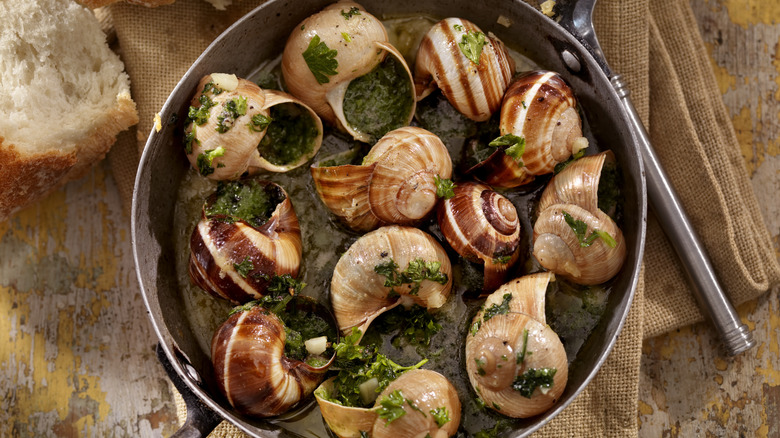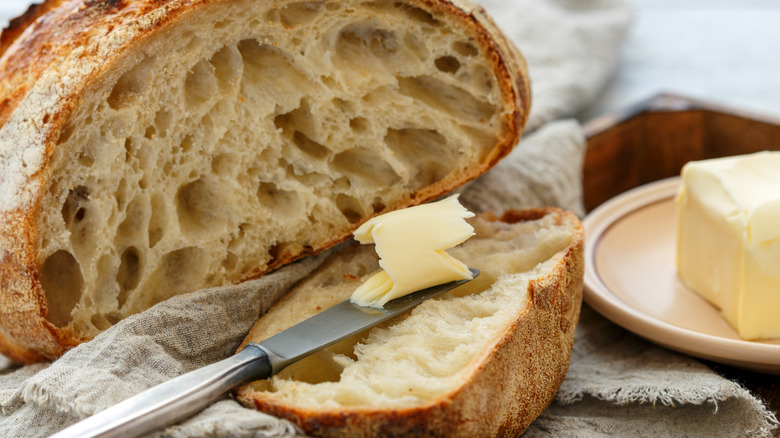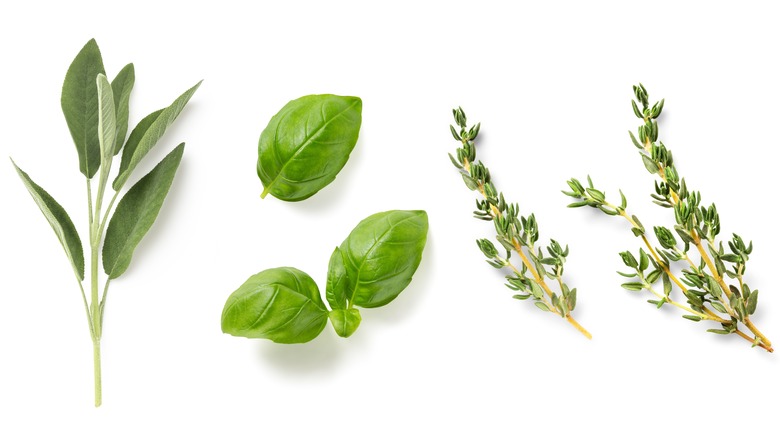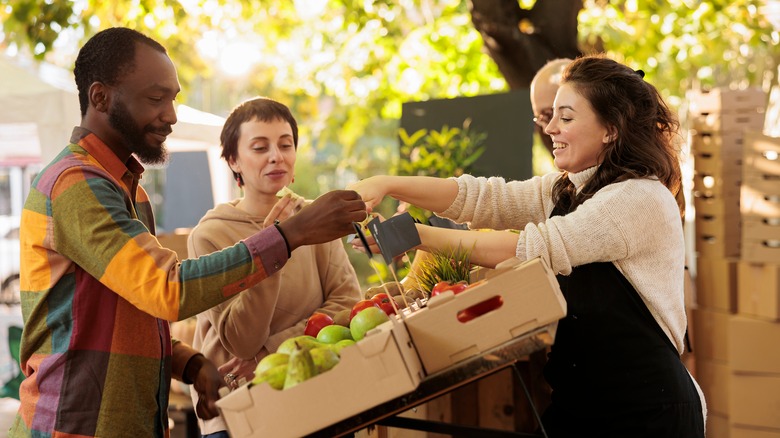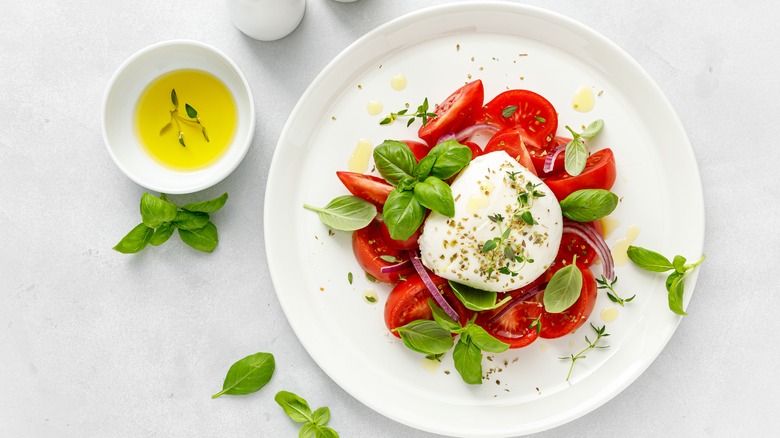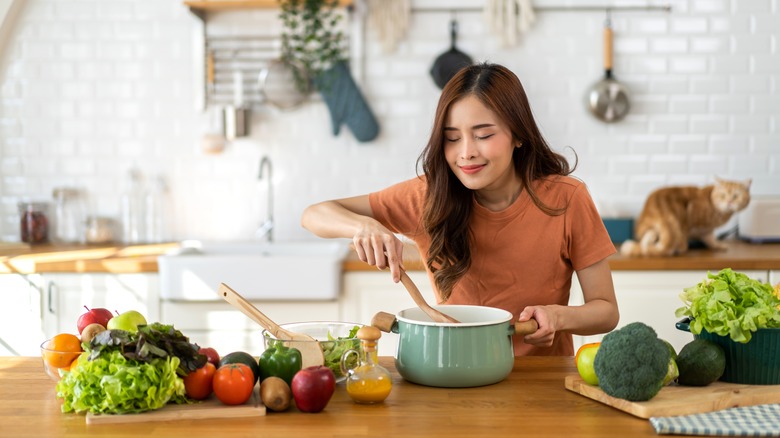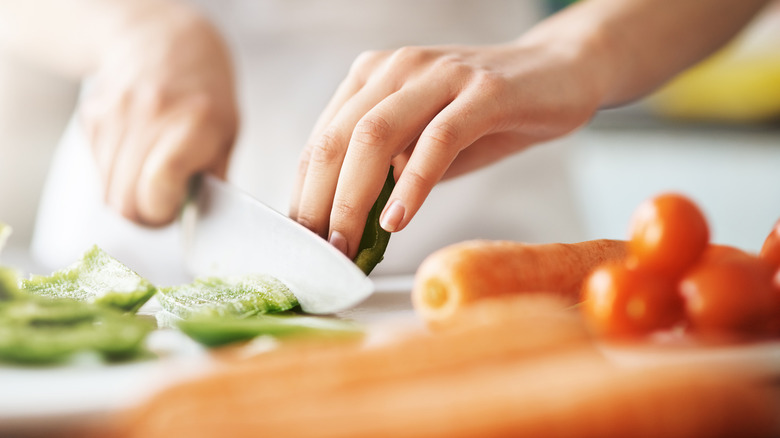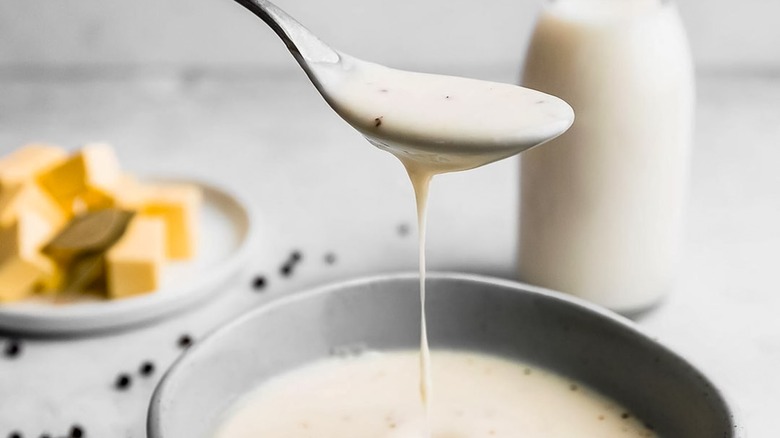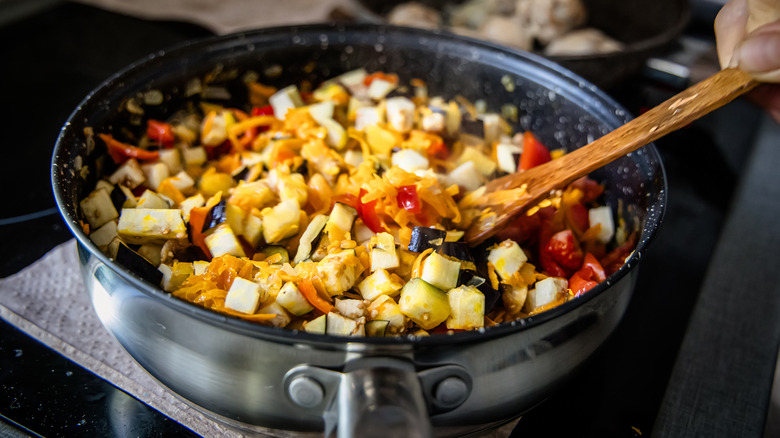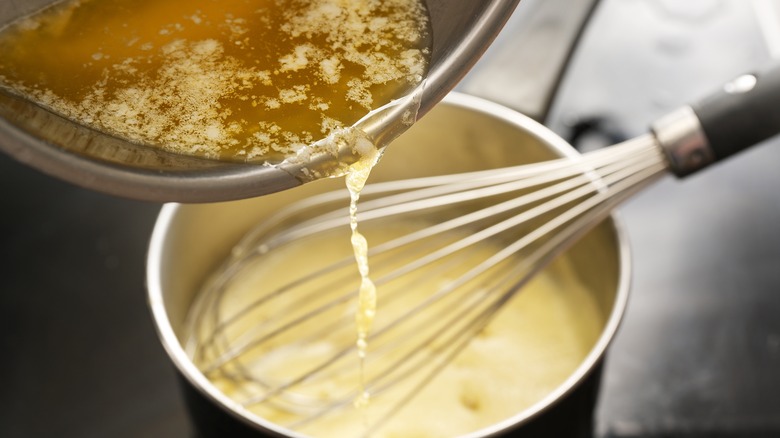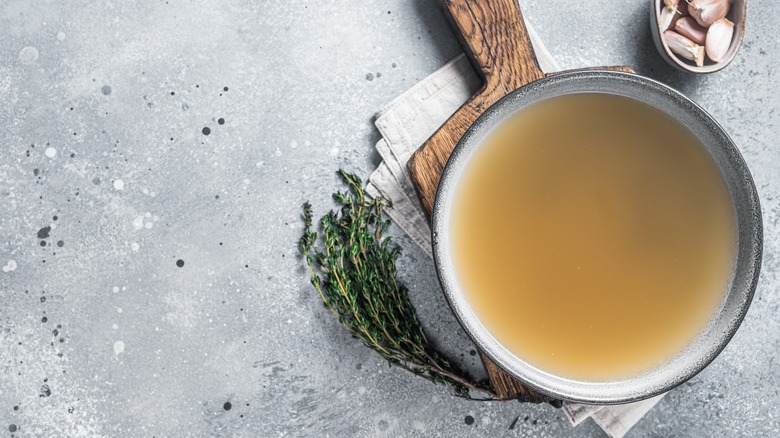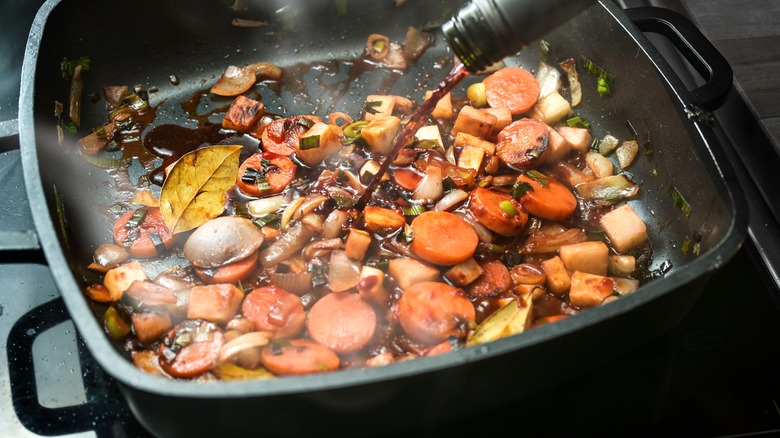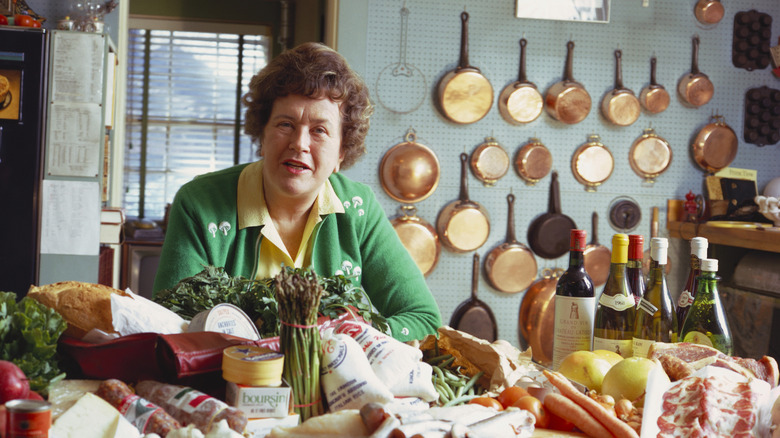French Cooking Tips That Will Take Your Food To The Next Level
French cooking has long been synonymous with culinary excellence, tracing its roots back to medieval times. From crafting elaborate feasts for monarchs to blossoming into a true renaissance of decadent cuisine in the 1900s, the country's gastronomy has consistently stood out as one of the most coveted and enduring in the realm of food. French cuisine has gradually become more accessible to aspiring home chefs over the past half-century, with iconic figures like Jacques Pépin and Julia Child leading the charge.
While recipes may appear intricate and luxurious, at its core, this type of cooking emphasizes the art of transforming simple, high-quality ingredients into thoughtful and flavorful dishes. While mastery of technique remains paramount, with a touch of mindfulness and dedication, anyone can acquire the skills to cook delicious French food à la maison. We've compiled some of the best tips to assist you on your journey toward embracing the indulgent flavors of this type of cuisine in your own kitchen.
Butter is always better
When it comes to French cooking, one is likely to conjure images of rich, buttery dishes. However, it's important to note that these dishes are typically not especially heavy or laden with cheese, as is common in many American comfort recipes. French cuisine offers a more refined richness, achieved through the addition of high-quality cream or butter. There's a playful saying that the true secret to this cuisine is "butter, butter, and more butter," and it's not far from the truth.
Whether you're whipping up a homemade hollandaise sauce, mastering Julia Child's luscious scrambled eggs, or indulging in a freshly baked baguette, the secret to elevating each of these culinary moments is indeed butter. Therefore, we recommend it as the easiest and most delicious way to embark on a journey into French cuisine at home. To ensure authenticity, head to a local high-quality grocery market or explore online sources for premium varieties.
Bordier butter exemplifies this — it's a French version with a devoted following. While primarily found in this European country, you can also discover it in select restaurants in New York City and order it online for a genuine taste of indulgence. But if you can't find it, try looking for the best butter at your grocery store which could be the gateway to helping you explore the wonderful world of French cooking.
A little herb goes a long way
Incorporating herbs and spices is another simple yet effective way to elevate your dishes at home and rival those crafted by French chefs. In the country's culinary tradition, they are highly valued for their ability to enhance delicate flavors and transform ordinary dishes into extraordinary creations. While dried herbs can suffice in a pinch, it's ideal to opt for fresh versions, as they have the most potency when freshly chopped.
Among the most commonly used types are the bouquet garni, fines herbes, and herbes de Provence. A bouquet garni typically consists of a few stalks of parsley, thyme, and a bay leaf tied together, allowing for easy removal at the end of cooking since the herbs are primarily there to impart flavor. Fines herbes typically comprise a blend of fresh parsley, chives, chervil, and sometimes tarragon. Lastly, the infamous herbes de Provence is often a dried mixture of fennel seed, oregano, and tarragon. While these combinations may seem complex, even sprinkling some freshly chopped green onion atop an omelet is a French-approved technique to elevate your breakfast.
While part of the allure of this type of cooking lies in the romanticism of it all, if space allows, growing these herbs in a garden or even on a windowsill can infuse your cuisine with a touch of flair or "magique." If growing them at home isn't feasible, we recommend checking out your local farmers' market for freshly grown herbs and spices.
Quality ingredients are worth it
Stereotypically, the French embody an effortless sense of romance as they complete their weekly grocery shopping. While megamarts now prevail throughout the country, many still embrace the traditional shopping method of frequenting local specialty stores for small quantities of fresh food. Unlike the American preference for one-stop shops, the French traditionally prioritize specialty shops like butchers and bakeries for quality meats and bread.
Rather than stockpiling provisions, they buy only what they need for the next day or so, ensuring freshness in their kitchen. Food holds a profound significance in French culture, often viewed as a pleasurable and creative pursuit. Rather than viewing grocery shopping as something you have to do, try to shift and see it as something you get to do.
Consider visiting the farmers market for fresh ingredients like tomatoes, pasta, and cream to create a delightful meal that evening. You could transform grocery shopping from a weekly chore into a daily opportunity to connect with your body and its cravings. Over time, you may find that investing time in cooking, as the French do, becomes a rewarding aspect of life.
Simplicity is the true essence of sophistication
While French cuisine may appear intimidating and let's be clear, there are indeed recipes demanding advanced culinary techniques — at its essence, the finest of these dishes often embrace simplicity. This holds particularly true for the everyday menus of the country's home chefs. From the bustling markets of Provence to the unfussy bistros of Paris, chefs prioritize quality produce and minimalistic preparation techniques.
The essence of French cuisine lies in enhancing the natural flavors of ingredients rather than overwhelming them with complexity. Even in something as basic as salad dressing, they approach flavor simply, often opting for a delicate blend of olive oil, vinegar, and a touch of Dijon mustard, allowing the vibrant taste of the greens to take center stage. This dedication to simplicity extends beyond the realm of food preparation to encompass the entire ethos of French cuisine, whether it's one's approach to curating the atmosphere of a laid-back party or the pleasure of extending the gathering over a thoughtful cheese board served after dinner.
It is important to remember that there is a clear distinction between simplicity and laziness. While the former is a deliberate choice to highlight the essence of ingredients and create a generally relaxed atmosphere, the latter reflects a lack of effort and care in preparation.
It's all about the je ne sais quoi factor
French cuisine possesses a certain "je ne sais quoi" factor that sets it apart and elevates it to a realm of culinary excellence. It's not just about the ingredients or techniques, it's about the artistry, passion, and meticulous attention to detail ingrained in every dish. Julia Child encapsulates this idea in her book, "The Art of French Cooking," when she mentions that cooking isn't just about the food, it's also about the love you bring to your recipes.
Beyond mere ingredients and recipes, Child emphasized the importance of imbuing every dish with heartfelt dedication and enthusiasm. For her, cooking was a joyful expression of creativity, where the act of preparing food became a deeply meaningful experience, connecting people and cultures through shared moments of culinary delight.
At the end of the day, French cooking isn't about intricate meals or fancy techniques, it's about the energy you bring into the kitchen. It's about using great ingredients and letting go of the pursuit of perfection as you prepare a delicious meal to enjoy, whether alone or with loved ones. So, turn on some music, pour yourself a glass of something delicious, and enjoy the experience because that's what truly matters.
Elevate your knife skills
While we wholeheartedly embrace the attitude and passion that defines the French cooking experience, we must not overlook the importance of technique. With a variety of methods in the country's culinary repertoire, mastering the art of traditional knife cuts can significantly enhance the flavors of ingredients and contribute to crafting distinctly French dishes. Proficiency in these skills not only ensures visually appealing food presentation but also guarantees that ingredients are cooked to perfection.
During training, chefs may dedicate months to mastering knife techniques. While mastering each cut may initially seem daunting for home cooks, it's essential to remember that culinary exploration is about embracing curiosity and taking things one step at a time. Whether it's mastering the allumette (slicing vegetables into matchstick slices), julienne (cutting vegetables into extremely thin strips), or mirepoix (dicing vegetables into small, rough cubes), learning these skills is a journey of continuous practice and discovery.
For those committed to honing their skills, we recommend seeking out local classes in your city or town, where you can learn directly from a chef who can ensure your safety throughout the process. Alternatively, if in-person classes are not available, there are also plenty of resources online that can teach you all about knives and when and why we use each type.
Become a champion of technique
As you delve into mastering French knife techniques, you'll encounter a diverse array of celebrated cooking methods. Mastery of key culinary methods, from flambéing to confit-ing, can elevate you from a home chef to a maître de cuisine. But why does French cuisine place such heavy emphasis on technique? This tradition dates back hundreds of years, with it evolving since the 14th century. Chef François Pierre La Varenne played a pivotal role in the 17th century by introducing technical sauces like béchamel, which distinctly elevated the cuisine from others.
Today, French cooking boasts a rich repertoire of techniques. While attempting to master them all may seem overwhelming, consider tackling them one by one, focusing on whichever piques your interest. These methods include flambéing, searing, sautéing, sous-vide, and poaching. Aside from learning in-person, Jacques Pépin offers excellent tutorials on YouTube to help you master the art of poaching the perfect egg for your next brunch.
Cooking slow and low wins the race
In French cuisine, the technique of cooking slow and low holds immense significance, epitomizing the art of patience. This method, often employed in braising, stewing, and simmering, allows ingredients to tenderize gradually while developing rich, complex flavors. By cooking at a gentle, controlled heat over an extended period, tough cuts of meat become succulent and tender, while vegetables soften and meld harmoniously with aromatic herbs and spices.
The slow and low approach not only imbues dishes with delectable depth and richness but also allows time for flavors to meld and evolve, resulting in a symphony of tastes that captivate the palate. This method reiterates the French culinary ethos of savoring each step of the cooking process, honoring tradition, and creating dishes that are both comforting and refined. From coq au vin to boeuf bourguignon, the timeless appeal of this method of cooking in French cuisine lies in its ability to transform humble ingredients into exquisite culinary masterpieces, inviting diners to indulge in a sensory journey that truly celebrates the potential of food.
Learn how to make a perfect roux
As you embark on your journey into the world of French cuisine, you'll inevitably encounter the roux — an essential cornerstone often hailed as the grandmother of sauces. Believed to have emerged during the 1700s, a roux is a humble blend of equal parts butter and flour, simmered together until it thickens into a base for rich, almost gravy-like sauces. Crafting it is a relatively straightforward process, with the primary hurdle lying in skillfully avoiding lumps when thickening the roux.
While deeply rooted in French culinary tradition, this sauce also has its place in Cajun and Creole cooking. Although the idea of crafting it may seem daunting at first, you can begin your journey with a classic American recipe — macaroni and cheese. Most homemade versions start with a simple roux that gradually transforms into a luxuriously thick cheese sauce. It's an excellent opportunity to hone your technique, preparing you to confidently tackle more complex and authentically French flavors in the future.
Sauce is everything
Once you've mastered the roux, delving into other traditional sauces will elevate your dishes to new heights. In the 19th century, French chef Auguste Escoffier defined the five mother sauces, known as "les grandes sauces" in French. These five foundational sauces are béchamel, velouté, espagnole, hollandaise, and tomato.
Béchamel, a creamy white sauce made from roux and milk, adds richness to dishes like gratins and lasagnas. Velouté, a light stock thickened with a roux, provides a delicate base for seafood or poultry dishes. Espagnole, a brown sauce crafted from brown stock and brown roux, offers depth and complexity, often used in hearty stews and braises. Hollandaise, an emulsified sauce of butter, egg yolks, and lemon juice, elevates breakfast classics like eggs Benedict with its luxurious texture and tangy flavor. Lastly, tomato sauce, simmered with the acidic fruit, aromatics, and herbs, brings vibrant color and zest to pasta, pizzas, and a variety of Mediterranean-inspired dishes.
Developing a keen understanding of the five mother sauces is a guaranteed path to turn your everyday home cooking into a French delight.
Learn how to make stocks and broth at home
In French cooking, stocks, and broths are key elements that form the foundation of many dishes. A good version can take a dish from average to something that has depth, richness, and complexity of flavor. These essential liquids, often simmered for hours with aromatic vegetables, herbs, and bones, serve as the backbone of sauces, soups, and stews. Whether it's the velvety texture of a classic velouté sauce, the robust flavor of a hearty beef bourguignon, or the delicate essence of a refined consommé, stocks and broths are the cornerstone of many French meals.
Mastering the art of preparing your own at home is a remarkable way to distinguish your dishes from the rest. Although it may initially seem daunting, the process is far more manageable than you might anticipate — the primary challenge lies in carving out the time to allow your ingredients to simmer for hours on the stove. Consider tucking this idea away for a cold, wintery day at home, when you can fully immerse yourself in the culinary experience. The immense flavor a homemade stock will bring to your next stew may make you never go back to the store-bought options.
Deglaze to get every last bit of flavor
Deglazing stands as a quintessential French culinary technique cherished for its ability to extract and enhance flavors while incorporating the essence of pan drippings into a dish. In short, it helps get all the good stuff stuck on the pan into the food. This method, deeply rooted in French culinary tradition, involves adding liquid — such as wine, broth, or vinegar — to a pan that has been used to cook meats or vegetables, loosening and dissolving the caramelized bits stuck to the bottom.
This results in concentrated flavors that form the foundation for rich sauces and reductions, immediately elevating the dish. Beyond its practical benefits, deglazing also embodies the French philosophy of maximizing flavor from simple ingredients. Its ability to add depth to sauces and gravies makes deglazing an essential and timeless technique in French cuisine, reflecting the emphasis on extracting the fullest potential from every ingredient and cooking step.
Find your muse
Having a muse or mentor to admire and glean wisdom from is essential when delving into the intricacies of French cuisine. From the legendary Jacques Pépin to the esteemed Dorie Greenspan and the iconic Julia Child, there is a plethora of chefs to draw inspiration from and learn invaluable techniques and recipes.
Each cook brings a unique perspective and expertise, offering a wealth of knowledge that can enrich your culinary journey. Whether through cookbooks, television shows, or engaging in-person classes, discovering a chef to illuminate your path can be crucial in mastering the art of French cooking. Finding a muse to look up to and learn from fosters a deeper appreciation for the culinary heritage of this country and can help keep you inspired as you navigate its varied methods.
Ultimately, the journey of mastering French food comes from the passion to learn more, practicing techniques, and seeking out those who inspire you.
